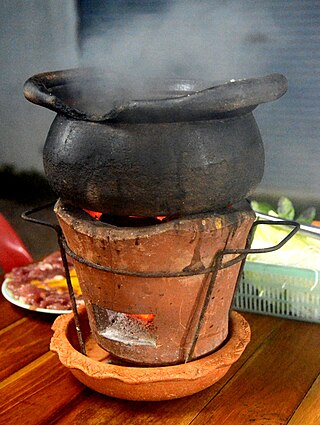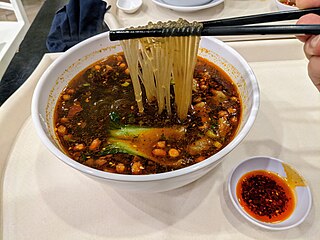
Beef noodle soup is a noodle soup made of stewed or braised beef, beef broth, vegetables and noodles. It exists in various forms throughout East and Southeast Asia.

Phở or pho is a Vietnamese soup dish consisting of broth, rice noodles, herbs, and meat – usually beef, sometimes chicken. Phở is a popular food in Vietnam where it is served in households, street-stalls, and restaurants country-wide. Residents of the city of Nam Định were the first to create Vietnamese traditional phở. It is considered Vietnam's national dish, and is said to be influenced by Chinese and French cultures.

Cellophane noodles, or fensi, sometimes called glass noodles, are a type of transparent noodle made from starch and water. A stabilizer such as chitosan may also be used.

Chinese Indonesian cuisine is characterized by the mixture of Chinese with local Indonesian style. Chinese Indonesians, mostly descendant of Han ethnic Hokkien and Hakka speakers, brought their legacy of Chinese cuisine, and modified some of the dishes with the addition of Indonesian ingredients, such as kecap manis, palm sugar, peanut sauce, chili, santan and local spices to form a hybrid Chinese-Indonesian cuisine. Some of the dishes and cakes share the same style as in Malaysia and Singapore, known as Nyonya cuisine by the Peranakan.

Korean Chinese cuisine, also known as Sino–Korean cuisine, is a hybrid cuisine developed by the ethnic Chinese in Korea.

Mee pok is a Chinese noodle characterized by its flat and yellow appearance, varying in thickness and width. The dish is of Chaoshan origin and is commonly served in the Chaoshan region of China and countries with a significant Chaoshan Chinese immigrant population such as Singapore, Malaysia and Thailand. Mee pok is commonly served tossed in a sauce, though sometimes served in a soup. Meat and vegetables are added on top.

Guizhou cuisine, or Qian cuisine, consists of cooking traditions and dishes from Guizhou Province in southwestern China. Guizhou cuisine shares many features with Sichuan cuisine and Hunan cuisine, especially in bringing the sensation of spiciness and pungency. What makes Guizhou cuisine unique is the emphasis of a mixed sour-and-spicy taste, as compared to the numbing-and-hot sensation featured in Sichuan cuisine and the dry-hot taste featured in Hunan cuisine. There is an ancient local saying, "Without eating a sour dish for three days, people will stagger with weak legs". The saying reflects how Guizhou people love local dishes with a sour taste. The combination of sour and spicy flavours is also found in Shaanxi cuisine. Guizhou cuisine differs from Shaanxi cuisine in that it lacks the emphasis on the salty taste, which is a common trait found in most northern Chinese cuisines. In addition, the unique sourness featured in Guizhou cuisine comes from the local tradition of fermenting vegetables or grains, and not from using vinegar products.

Mixian is a type of rice noodle from the Yunnan Province, China. These noodle are typically distinguished by their round shape, moderate thickness, and smooth, silky texture. They are normally used fresh and are commonly seen in stir-fry recipes, often served with rich broths and sauces.

Paomo is a specialty of Shaanxi cuisine and is a typical food eaten in the city of Xi'an and other cities of Guanzhong. It is a hot stew of chopped-up steamed leavened flat bread, known regionally as mo, cooked in lamb broth and served with lamb meat, sometimes substituted with beef.

Crossing-the-bridge noodles is a rice noodle soup that originates from the Yunnan province of China. It is one of the best-known dishes in Yunnan cuisine.

Luosifen is a Chinese noodle soup and specialty of Liuzhou, Guangxi. The dish consists of rice noodles boiled and served in a soup. The stock that forms the soup is made by stewing river snails and pork bones for several hours with black cardamom, fennel seed, dried tangerine peel, cassia bark, cloves, white pepper, bay leaf, licorice root, sand ginger, and star anise. It usually does not contain snail meat, but it is instead served with pickled bamboo shoot, pickled green beans, shredded wood ear, fu zhu, fresh green vegetables, peanuts, and chili oil added to the soup. Many often recognize this noodle dish as something stinky. This dish is full of umami and attracts many not just in China but also outside of China to visit just for this dish. Diners can also add chili, green onions, white vinegar, and green peppers to suit their taste.

Chim chum is a Southeast Asian street food, popular especially in Thailand. It is traditionally made with chicken or pork and fresh herbs such as galangal, sweet basil, lemongrass and kaffir lime leaves, cooked in a small clay pot on a charcoal stove. It is often served with nam chim.

Hot and sour soup is a popular example of Chinese cuisine. Although it is said to be originated in Sichuan, this is actually a variant of hulatang or "pepper hot soup" (胡辣汤) with added vinegar to enhance the sourness. This variation is found in Henan province, and in Henan cuisine itself. Also popular in Southeast Asia, India, Pakistan and the United States, it is a flexible soup which allows ingredients to be substituted or added depending on availability. For example, the American-Chinese version can be thicker as it commonly includes corn starch, while in Japan, sake is often added.

Mala is a spicy and numbing seasoning made from Sichuan peppercorn and chilli. Most commonly, mala is made into a sauce by simmering it in oil and other spices. Characteristic of Sichuan cuisine, particularly Chongqing cuisine, it has become one of the most popular ingredients in Chinese cuisine, spawning many regional variants.

A wonton is a type of Chinese dumpling commonly found across regional styles of Chinese cuisine. It is also spelled wantan or wuntun in transliteration from Cantonese 雲吞 / 云吞 and wenden from Shanghainese 餛飩 / 馄饨. Even though there are many different styles of wonton served throughout China, Cantonese wontons are the most popular in the West due to the predominance of Cantonese restaurants overseas.

Hot pot or hotpot, also known as steamboat, is a dish of soup stock, kept simmering by a heat source on the table, accompanied by an array of raw meats and vegetables which diners dip and cook in the broth.

Hot and sour noodles is a dish which comes from Sichuan, China and is a popular part of Sichuan cuisine. The noodles are made from starch derived from peas, potato, sweet potato, or rice.

Taiwanese beef noodle soup is a beef noodle soup dish that originated in Taiwan. It is sometimes referred to as "Sichuan beef noodle soup" in Taiwan, although this usage can create confusion as Sichuan has its own versions of beef noodle soups. which may be sold at Sichuanese restaurants under the same name. The beef is often stewed with the broth and simmered, sometimes for hours. Chefs also let the stock simmer for long periods with bone marrow; some vendors can cook the beef stock for over 24 hours. In Taiwan, beef noodle vendors may also have optional, often cold side dishes, such as braised dried tofu, seaweed or pork intestine. Beef noodles are often served with suan cai on top, green onion and sometimes other vegetables in the soup as well.

Kuanfen noodles are broad Chinese noodles made from potatoes. They are commonly used in hotpot and stew. They can also be made from purple potatoes.


















